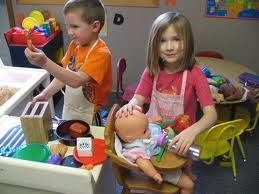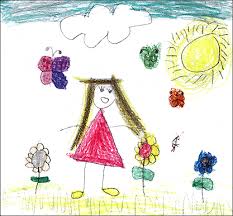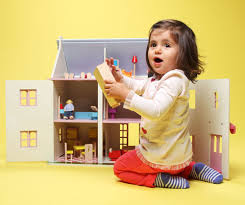Summary: Offer your children a wide range of toys that encourage creativity, imagination and active play.
Try to offer a variety of toys to your child to address different types of development and thinking. Make sure the toys match where the child is cognitively. Also, avoid toys that may be marketed well but limit your child’s develpment.
The following are different categories of children’s toys. Try and offer your child toys from each group to encourage development in all areas.
Sensory/physical: balls, sand play, etc.

Representational: dress up clothes, plastic phones, emotionally charged toys (wands, baby items, etc.)
Construction: unit blocks, Tinker-Toys
Gross/fine motor: balance beam, painting
Different toys cue children to play in different ways. A ball cues children to run and kick. A puzzle promotes fine motor skills and is more suggestive of solitary play. Dress up clothes, wands, etc., “invite children to incorporate their own fantasies, images, roles and scripts into their play” (Van Hoorn, p.324). For specific recommendations on toys, read the Teachers Resisting Unhealthy Children’s Entertainment (TRUCE) website http://www.truceteachers.org/guides.htm.
Toys can also be categorized as close-ended (convergent) or open-end (divergent). Some toys are close ended meaning there is only one way to play with them such as locks and keys. Open ended toys are important because children can apply their own meanings and actions to the toys. This empowers children and fosters creativity. Crayons, paint, construction and dress up toys are examples of open ended toys.
Choose toys that children are intellectually capable of playing with. According to Piaget, children have biological timetables for how they perceive the world. Children two and under cannot abstract or imagine. They are physical so you can offer them balls, trucks, items with texture or other motor/sensorial toys. From 3 to 6, children begin to abstract and imagine so you can provide cardboard boxes, dress up clothes etc. as props for their play. Starting around 6, children can understand external rules so board games and hopscotch become more appropriate.

Avoid toys that limit your child’s development. Some toys sexualize children or encourage older behavior for younger children. Other toys teach power comes through violence. Certain toys can undermine imagination, creativity and abstraction because they do all the thinking for the child. Unlike unit blocks which can be used in multiple ways over many years, some toys only have a single use. For example, action figures with a specific role to play limit the imagination used with that doll. Some toys encourage thinking that people are either all good or all evil. Many toys encourage consumerism. Manufacturers often design products to be collector items so that children will buy more and more pieces. Avoid these kinds of toys.
Children benefit from a variety of toys to play with. Fortunately, they do not need to be store bought or expensive to foster emotional, social, cognitive and physical growth in your child.
REFERENCE
Van Hoorn, J., Nourot, P. M., Scales, B., & Alward, K. R. (2011). Play at the Center of the Curriculum. Upper Saddle River, NJ: Pearson.



